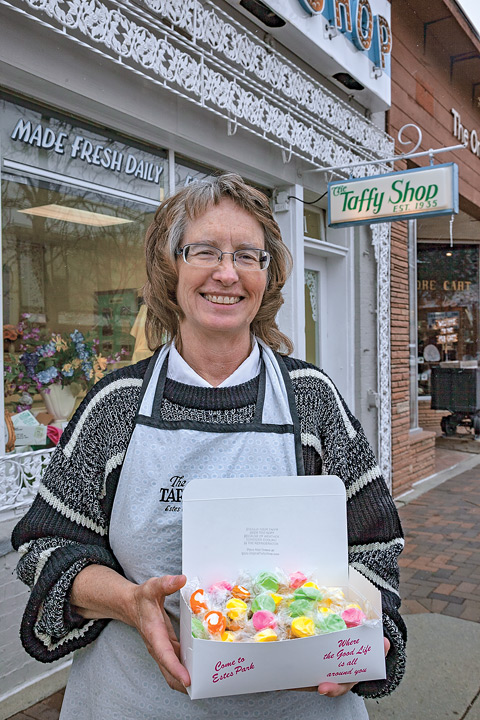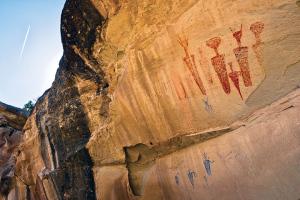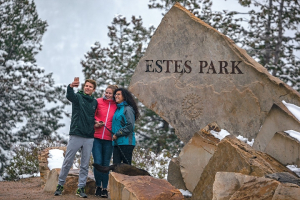There are, in fact, two distinct types of elk jams in Estes Park. In the first type, the animals physically block the road. Residents are calmly resigned to these, though out-of-towners can be less understanding. The officers of the Estes Park Police Department repeat a favorite story about a tourist calling in to ask, “Who is in charge of the roads and the elk in this town? They’re tying up traffic.”
“Who is in charge of the roads?” the officer on desk duty replied. “I guess the elk are.”
It’s the second type of elk jam, where tourists stop in the middle of the street to snap photos of elk that are well off the road, that raises the blood pressure of longtime Estes Park residents. Still, it’s a small price to pay for living in one of the most beautiful places on earth.
The park in Estes Park’s name comes from the old Western term for a broad mountain valley, fitting for this patch of land encircled by mountains, but when people in town talk about “The Park,” they’re referring to something else: Rocky Mountain National Park.
The nation’s fourth-most-visited national park – 415 square miles of snow-capped peaks, cascading waterfalls, serene lakes and quiet meadows – lies just minutes west of downtown Estes Park. The natural beauty of this place has defined life in Estes Park from its earliest days. Patsey Estes, who with rancher husband, Joel, founded the community in 1859, said that living here was “like living on the front doorstep of heaven.”
Many of the 6,000 people living today in Estes Park can actually make a living here on heaven’s doorstep thanks to the 3.1 million people who visit town each year. Because tourism accounts for most of the money in the town’s coffers, the people working here often find little time to enjoy the national park during the bustling summer tourist season.
A hush falls over Estes Park when the crowds of summer depart. As the alpenglow fades into surrounding peaks, thousands of tiny holiday lights light up Elkhorn Avenue. In the distance, the Stanley Hotel bell tower chimes the hour, and water gurgles under the ice of the Big Thompson and Fall rivers. For many in Estes Park, winter is the time they can reconnect with all the things that made them love this place to begin with.
Zach Zehr, manager of the Estes Park Mountain Shop, keeps phenomenally busy during the summer fixing bikes and selling outdoor gear, and he’s only slightly less busy tuning skis in the winter. Even so, the lure of the national park is strong enough that, no matter the season, he always finds the time to get out. Starting at 4 a.m., he goes rock climbing, mountain biking or backcountry skiing – or some combination thereof – and gets in a day’s worth of adventure before beginning his day at work.
Most people live in Estes Park to enjoy the outdoors, but Zehr takes that lifestyle to its logical extreme. He and friends sometimes bike with skis on their backs up Trail Ridge Road to the top of Sundance Mountain, then strap the bikes to their backpacks and ski down to Fall River Road before switching back to bikes for the ride home.
There are, as Zehr puts it, “a lot of local crazy people” who are up for accompanying him into the national park for ski mountaineering expeditions, which combine technical climbing and backcountry skiing. On Ypsilon Mountain, he and a friend skied down Y Couloir, an impossibly steep gully on the mountain’s face that plunges more vertically than horizontally.
“You have to be very precise,” Zehr said. “If you were to fall or lose your skis, you would die – or at least get really messed up.”
That’s because there’s a 200-foot cliff halfway down the ski run. Zehr and his partner had to stop on a dime and use ropes and anchors to rappel down to finish skiing. Not all of his outings are so extreme. He often skis with his children at the more welcoming Hidden Valley, an abandoned commercial ski area in the national park whose ski lifts shut down for good in 1991. “I have a 4-year-old and a 6-year-old, and both of those kids grew up riding in my backpack down that mountain,” he said.

.jpg)
As alluring as the national park is, many people are so charmed with the town of Estes Park that they never make it past Elkhorn Avenue, the town’s Main Street, home to a staggering array of gift shops. T-shirt shops stock clothing emblazoned with wildlife designs (and a truly impressive variety of moose puns), and there are no fewer than three year-round Christmas stores. Four Estes Park confectionaries whip up taffy and fudge, with the granddaddy being known simply as The Taffy Shop. In the shop window of this 82-year-old Estes Park mainstay is a mesmerizing taffy machine that continually stretches and folds taffy that’s made from a top-secret recipe.
Not every Estes Park shopper is human. Jo Adams, owner of the Rocky Mountain Chocolate Factory, recounted how a bear visited her store in the dead of night, gaining entry through a faulty lock. The bear made seven different forays inside to select treats, each time taking them outside to eat. “He was so tidy,” Adams said. “He didn’t knock over or break anything. And he didn’t ‘leave’ anything. He just ate 20 pounds of chocolate and had the time of his life.”
Similarly, a massive six-point bull elk strolled through the open door of the Water Wheel Gift Corner just before Valentine’s Day this year. The bull hung around inside the shop for most of an hour, content to soak up the vibes. “He nosed around some stuffed animals,” owner Prateek Shakya said, “and believe it or not, was really interested in this.” Shakya held up a stuffed toy elk complete with antlers, concluding, “I think he was looking for a Valentine’s gift.”

The red-roofed Stanley Hotel has been the town’s centerpiece for more than a century. The hotel’s founder, entrepreneur F.O. Stanley, co-inventor of the Stanley Steamer automobile, came to Estes in a last-ditch effort to heal his chronic tuberculosis. Stanley and his wife adored the wild scenery but weren’t so keen on the rustic lifestyle, leading him to build the stately Georgian Revival hotel so he could lure well-heeled vacationers from back East.
The Stanley Hotel first gained fame for its luxury, but it’s best known today for its ghosts, thanks to novelist Stephen King’s uneasy stay in Room 217, which inspired him to write the bestselling horror novel The Shining. The novel’s acclaimed 1980 movie adaptation cemented the Stanley’s reputation, even though it wasn’t actually filmed here. The hotel is so well known for supernatural activity that more than a few breathless tourists arrive at the hotel primed to experience hauntings. It’s not that it won’t happen, explained practical Stanley Hotel tour guide Lillian Steele, but if you’re feeling strange while at the hotel, “you’re probably not having a paranormal experience. Most likely it’s just altitude sickness.”
Singer-songwriter Cowboy Brad Fitch has led singalongs in the town’s Bond Park for 20 years. Playing John Denver’s “Rocky Mountain High,” he said, is “required by law, and in accordance with state facilitators.” The song evokes the idealized version of life in the Rockies that many people here cherish. But Fitch, who grew up in Estes Park, knows that living so close to heaven isn’t without its price. “Estes Park is a tremendously healing place, but it can also be a devastating place,” he said.
Since 1976, the town has experienced three major floods, along with a downtown fire in 2009 and the 2012 Woodland Heights wildfire near the Beaver Meadows national park entrance. Most recently, it was the great 2013 flood that nearly brought the town to its knees. After days of rain, on the morning of Sept. 12, real estate agent Judy Nystrom drove into an eerily silent downtown. Suddenly she saw a wave of water coming straight at her. Nystrom managed to spin her car around and barely outrace the rushing water. It was the wave that ultimately flooded downtown Estes Park
This “thousand-year flood” completely cut off Estes Park from the outside world. Homes and businesses were filled with silt, sludge and broken asphalt. Highways 34 and 36 – the major routes in and out of Estes Park – were virtually destroyed. A landslide closed Highway 7 at the Aspen Lodge. Houses collapsed, roads disintegrated and vehicles washed away. Cell phones, land lines and internet connections were out. Main thoroughfares became rivers. The only way in and out of the valley was over the Continental Divide to Grand Lake via the 48-mile-long Trail Ridge Road.
Neighbors shared food, water and pet food, formed cleanup crews and set up ziplines over watery thoroughfares. Restaurants turned into community kitchens. Citizens organized dozens of impromptu fundraisers overnight to help the afflicted. Kind Coffee on Elkhorn Avenue introduced a Flood Mud coffee blend. “Hurricane Katrina survivors were buying our coffee in solidarity, telling us, ‘You’ll survive,’ ” owner Amy Hamrick said. “And we did.” Gary and Kris Hazelton, publishers of the Estes Park News, designed the Mountain Strong logo that immediately became the region’s rallying cry.
Two months after the flood, the town came together for the annual Catch the Glow holiday parade. The downtown district was so crammed with well-wishers that the sidewalks were eight people deep, making it nearly impossible to move – and there wasn’t a dry eye in the house.
The 2013 parade included floats that thanked rescuing heroes. In a nod to affected sewer lines, a float of port-a-potties also paraded by, adorned with masses of twinkling Christmas lights.
“Catch the Glow wasn’t just a celebration of the year,” said Julia Daley, who grew up here. “It was a celebration of the community. You don’t know how fabulous you are until something like this happens.”
Estes Park is back to its old self four years later. On Nov. 24, the Friday night after Thanksgiving, the Catch the Glow Parade brings its seasonal aroma of hot chocolate, warm cider and cinnamon-roasted nuts mingling with the sound of carolers, bell ringers and marching bands. This year’s parade celebrates the centennial year of Estes Park’s formal incorporation as a town. The people have gone through a lot to make it to the century mark, but it has been worth it. As Cowboy Brad Fitch puts it, “There’s nothing that can compare to Estes Park.”
Subscribe to Colorado Life Magazine and receive thoughtful stories and beautiful photography featuring travel, history, food, nature and communities of Colorado.






The information below is required for social login
Sign In
Create New Account